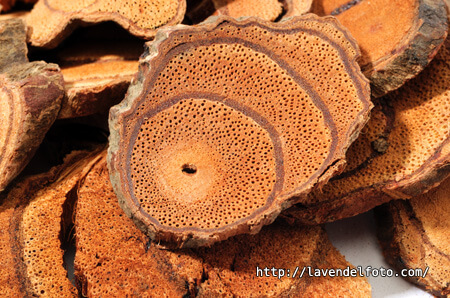Overview
Spatholobus (Latin name: Spatholobi Caulis; Chinese Name: Ji Xue Teng) is the dried vine (stem) of Spatholobus suberectus Dunn (Leguminosae) plant. The plant grows mainly in Guangxi, Fujian, Guangdong and Yunnan provinces in China. The veins are collected in autumn and winter, cut into ~30cm pieces or sliced, and dried naturally. The light brown slices characterized with beautiful reddish brown rings make the appearance of the crude dry herb distinct.
Spatholobus is a commonly used traditional Chinese herb, for treating gynecological and skeleton-muscular conditions. The earliest record of its medical use was in a classic work titled “Ben Cao Gang Mu Shi Yi” (A Supplement to the Compendium of Materia Medica), compiled during 18th century in China.
Traditionally, the dried herb can be used in combination with other herbs to make a decoction, or soaked in Chinese rice wine and consumed as an alcoholic health drink.
Spatholobus can also be found as one of the ingredients in several formulated TCM products, for similar indications.
The chemical constituents of Spatholobus include flavonoid, terpene, sterols, anthraquinones, lactone and volatile oil. Many of these ingredients are found to possess anti-oxidant and anti-inflammatory effects.
Clinical benefits
Due to its TCM function of improving circulation, nourishing blood, strengthening and mobilizing ligament and tendon, spatholobus is used for a wide range of indications, including anemia, menstrual abnormities (irregular menstruation, dysmenorrhea and amenorrhea), and chronic pain, numbness and stiffness caused by arthritis or injury.
There are also clinical research reports showing its benefit for treating leukopenia (a decrease in the number of white blood cells), and hyperplasia of the mammary glands.
Pharmacology effects
Results from many of the pharmacological studies support its traditional use. In one study, an ethanol extract of Spatholobus was found to accelerate the recovery of white blood cells, red blood cell and platelet counts in peripheral blood of mice with bone marrow suppression [1]. In another study a water extract of spatholobus was demonstrated to inhibit osteoclast differentiation and function, which suggest that it has a potential for treating pathological bone diseases caused by excessive bone resorption [2]
Results from more recent studies provided insight for further potential clinical benefits, including:
Cancer treatment: several studies have shown that spatholobus extracts have cytotoxic effect and can inhibit tumor grow
Brain protection: A recent study demonstrated the neuro-protective effect of Spatholobus in cerebral ischemic rats and concluded that this effect attributed to its antioxidant, anti-apoptotic and anti-inflammatory activity [4]
Some other reports showed that spatholobus stem has effects in promoting hematopoiesis function, expanding blood vessels, anti-coagulation, enhancing uterine contraction, reducing blood lipid, anti-tumor, anti-virus, immune modulation, anti-inflammation, antioxidant, tranquilizing and promoting sleep [7,8,9]
References:
- Wang H, Liu P, Dai C, Wang DX. Effects of heterogenous suberect spatholobus stem on peripheral blood cell counts of 60Co ? ray irradiated mice. J Chin Integr Med / Zhong Xi Yi Jie He Xue Bao. 2007; 5(2): 189-192]
- Hyunil Ha, Ki-Shuk Shim, Hyosun An. et al. Water extract of Spatholobus suberectus inhibits osteoclast differentiation and bone resorption, BMC Complementary and Alternative Medicine 2013, 13:112]
- Wang H, Liu Y, Zeng Z, He W. Study on HPLC chromatographic fingerprint of anti-tumor active site SSCE of Caulis spatholobi. Zhongguo Zhong Yao Za Zhi 2011; 36: 2525-2529.
- Kang IC, Kim SA, Song GY, Baek NI, Park YD, Ryu SY, Saiki I, Kim SH. Effects of the ethyl acetate fraction of Spatholobi caulis on tumour cell aggregation and migration. Phytother Res 2003; 17: 163-167.
- Liu B, Liu JL, Chen J, Zhu DM, Zhou HJ and Wang XM. A Study on Anticancer Activity of Caulis Spatholobi Extract on Human Osteosarcoma Saos-2 Cells. Afr J Tradit Complement Altern Med 2013; 10: 256-260.
- Rui Zhang, Cui Liu, Xuejun Liu & Yunliang Guo, Protective effect of Spatholobus suberectus on brain tissues in cerebral ischemia, Am J Transl Res 2016;8(9):3963-3969]
- Lui Daiquan (editor-in-chief), Chinese Herbal Medicine, Shanghai Scientific and Technical Publishers, 2000-6.

